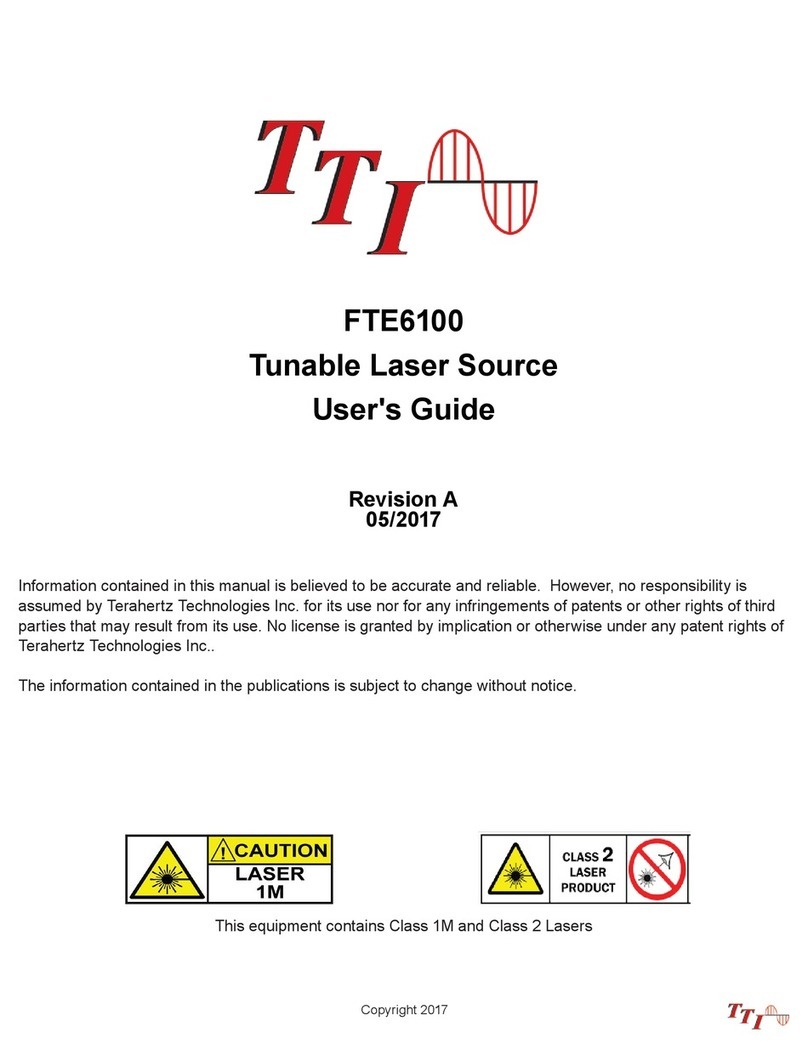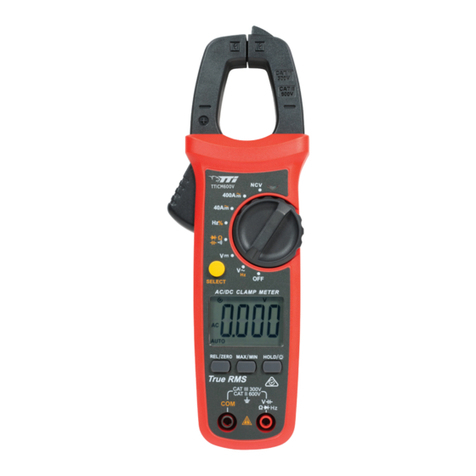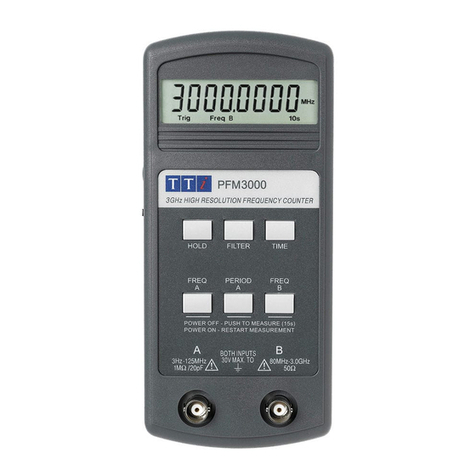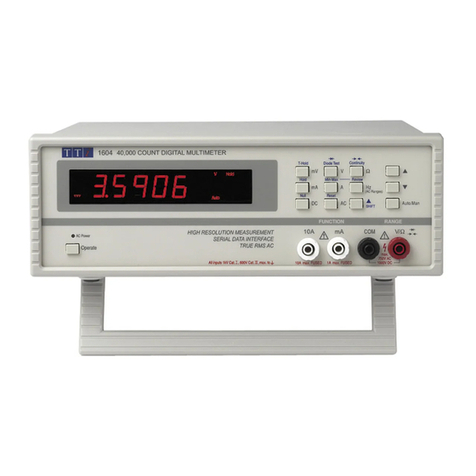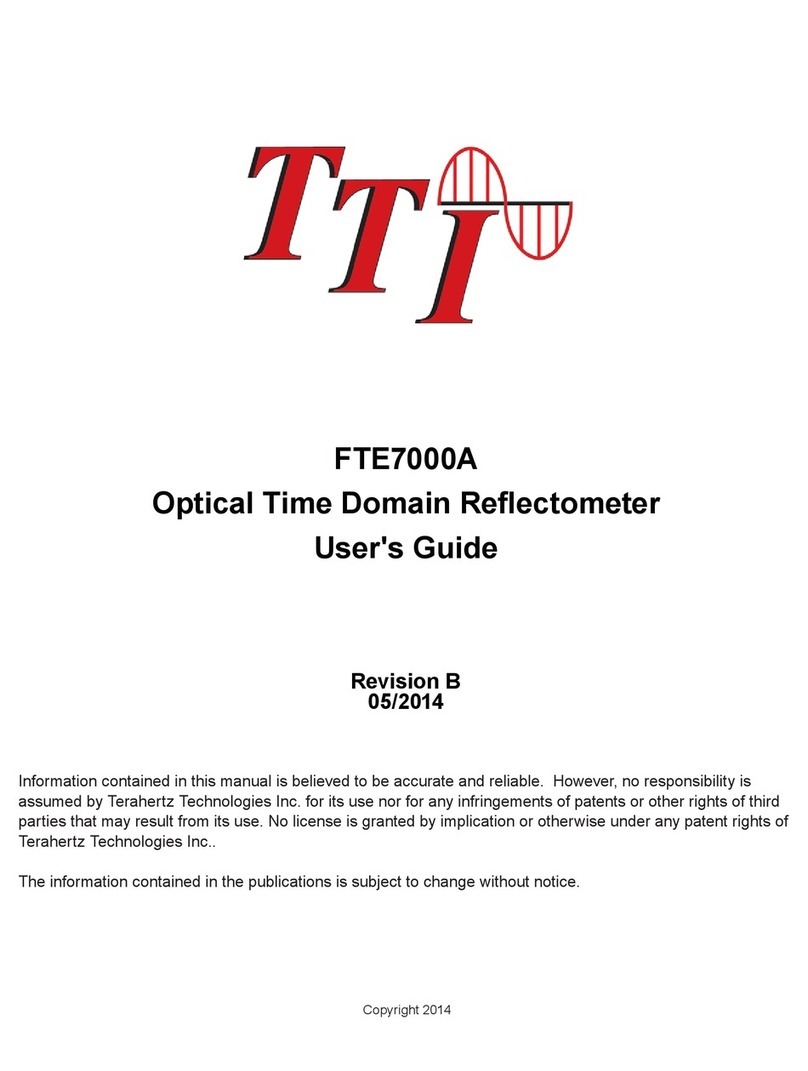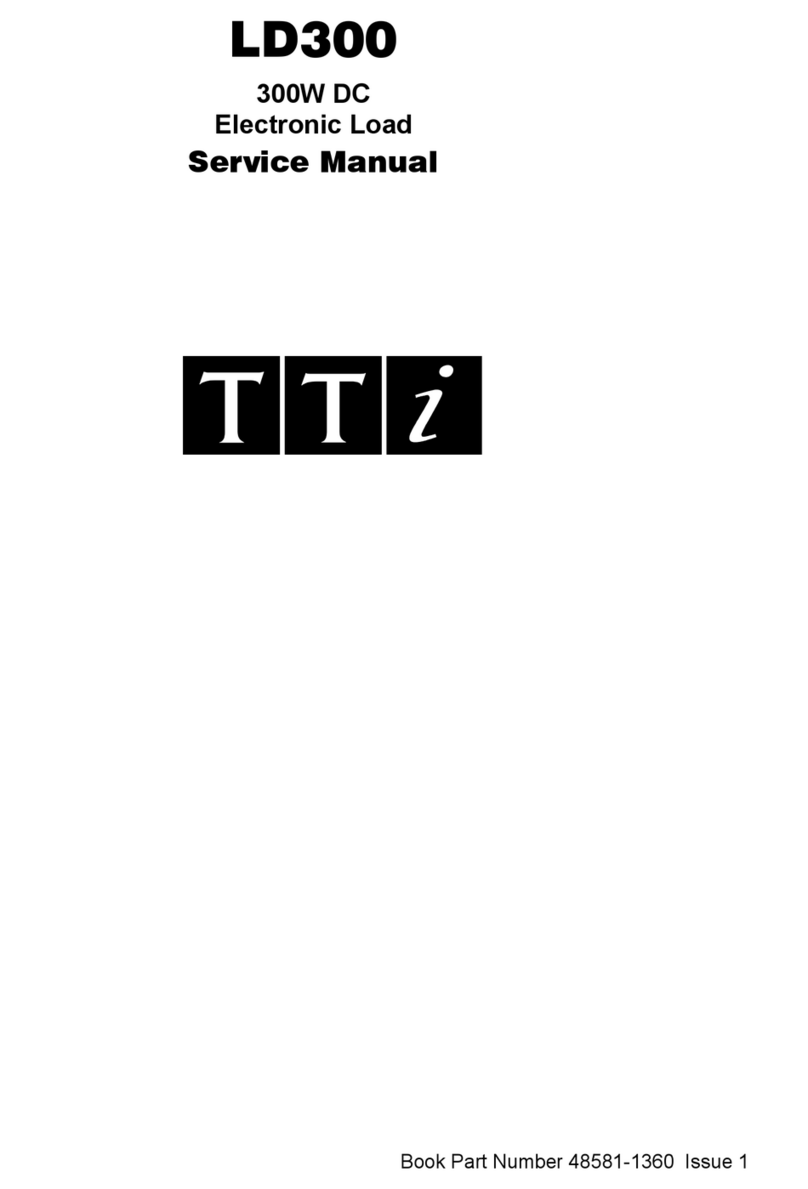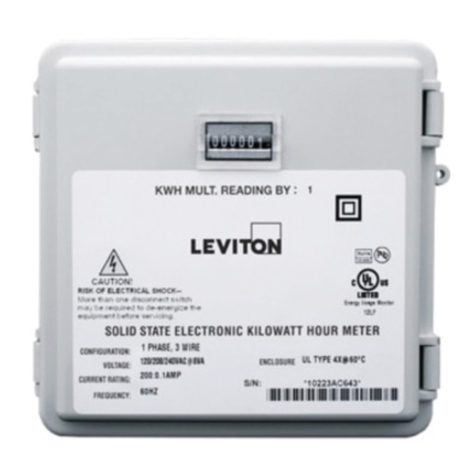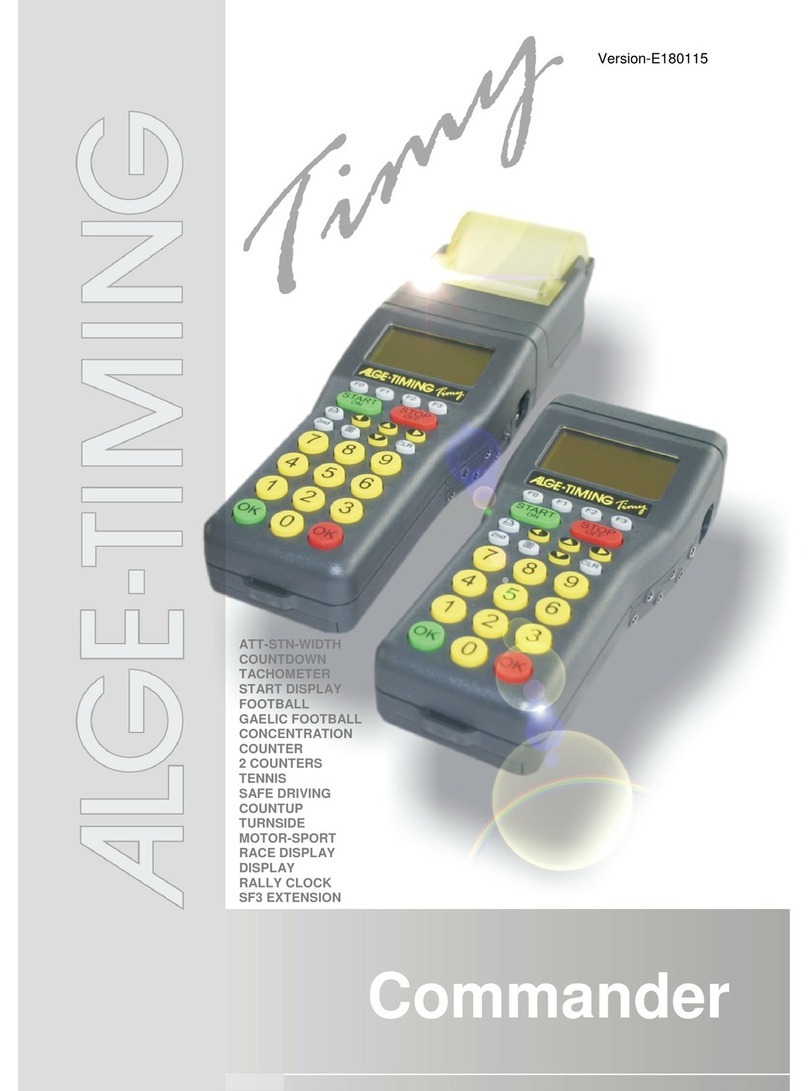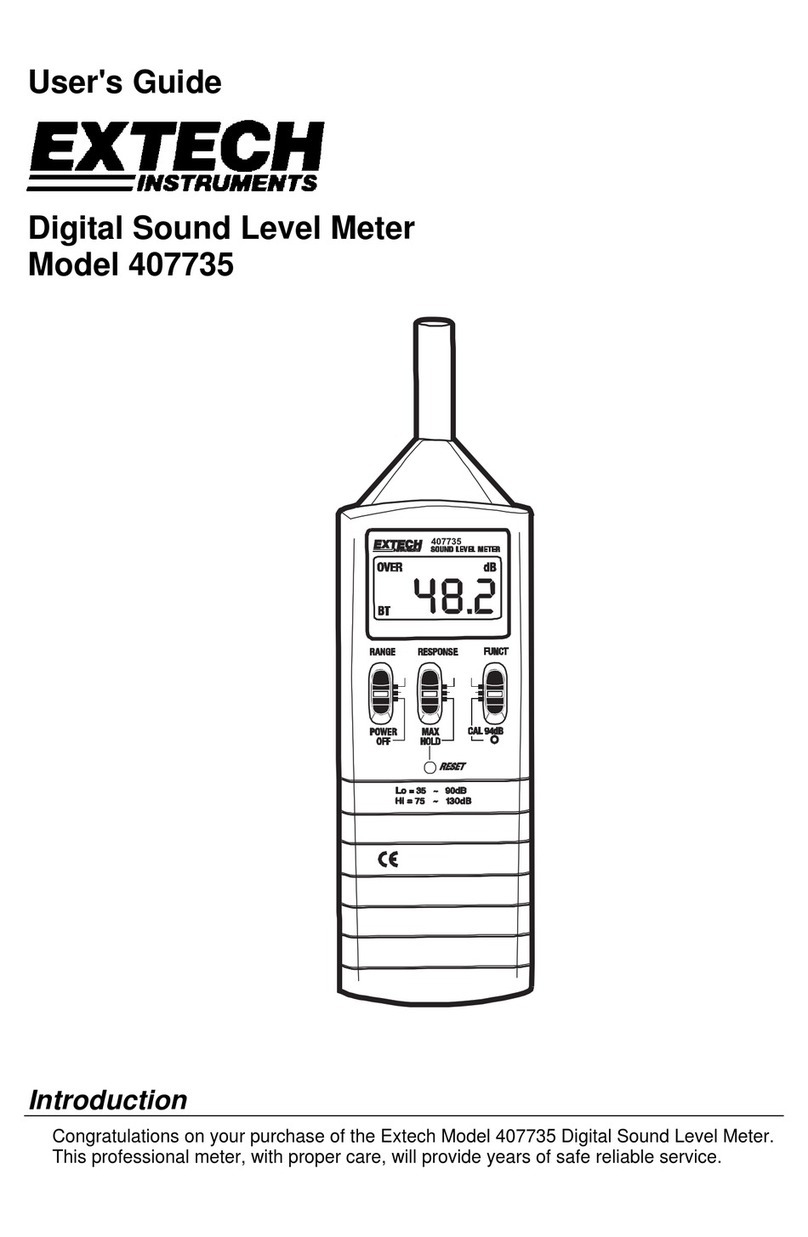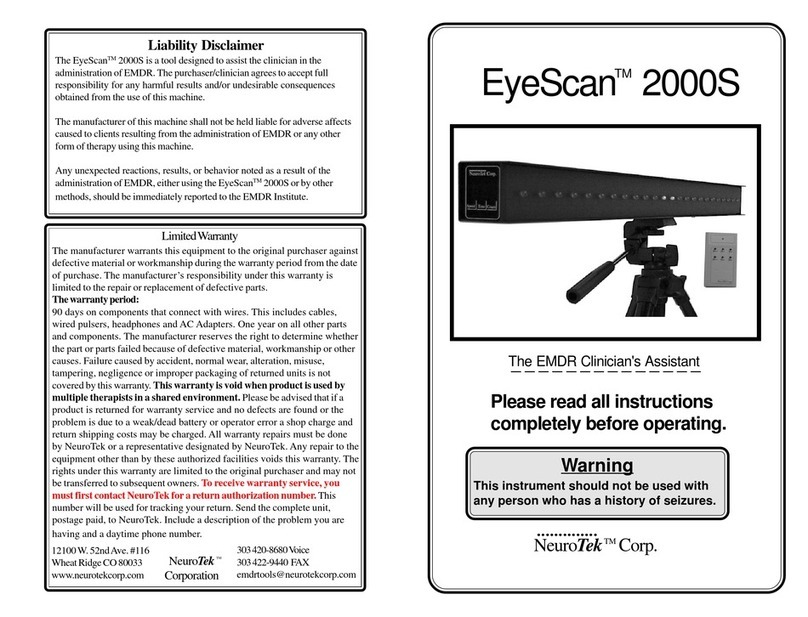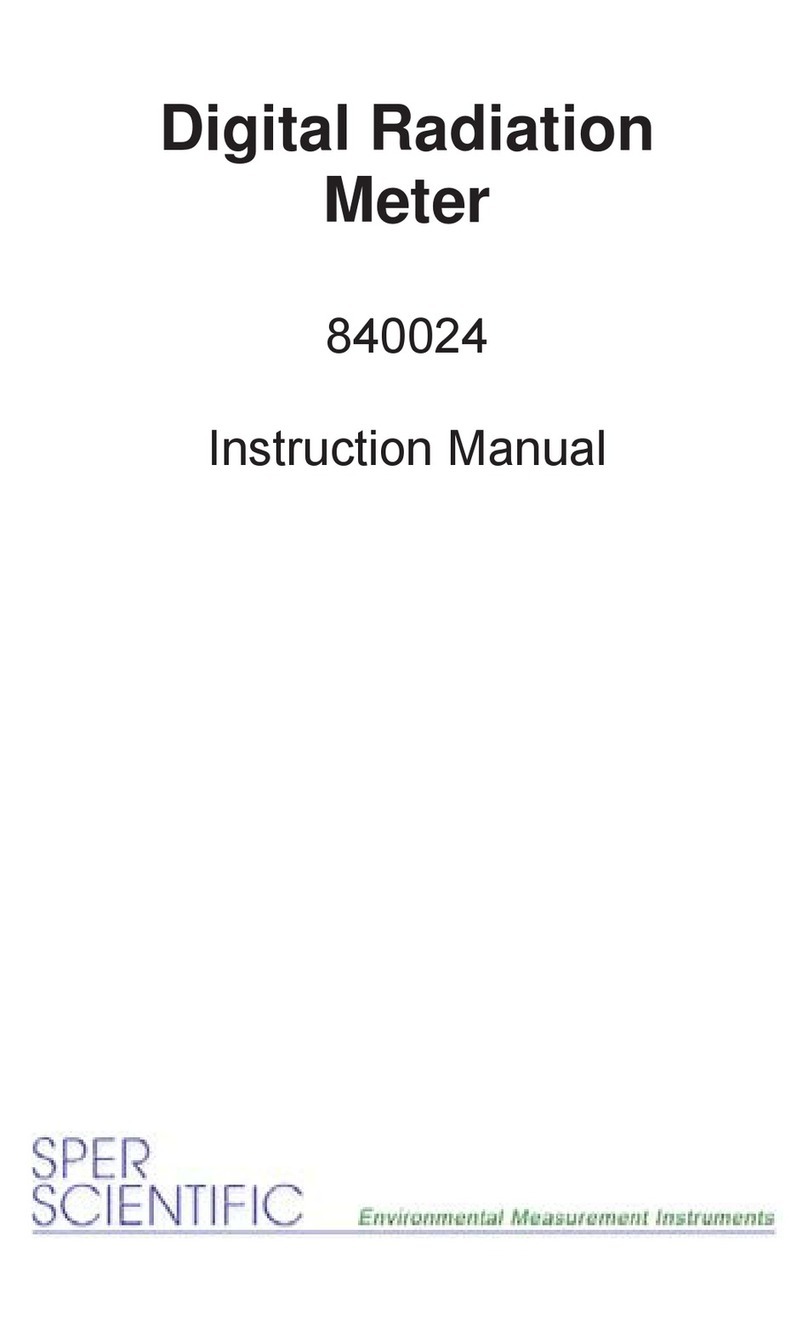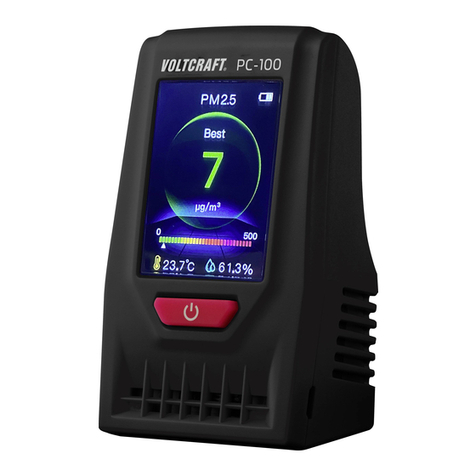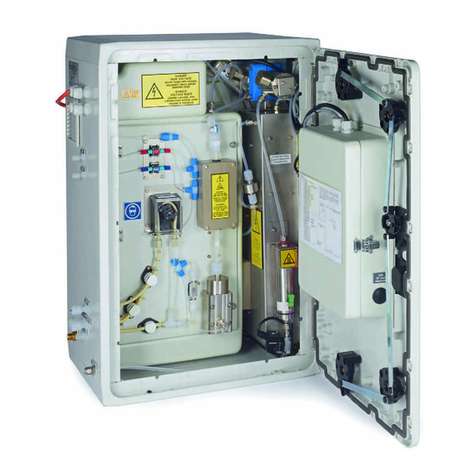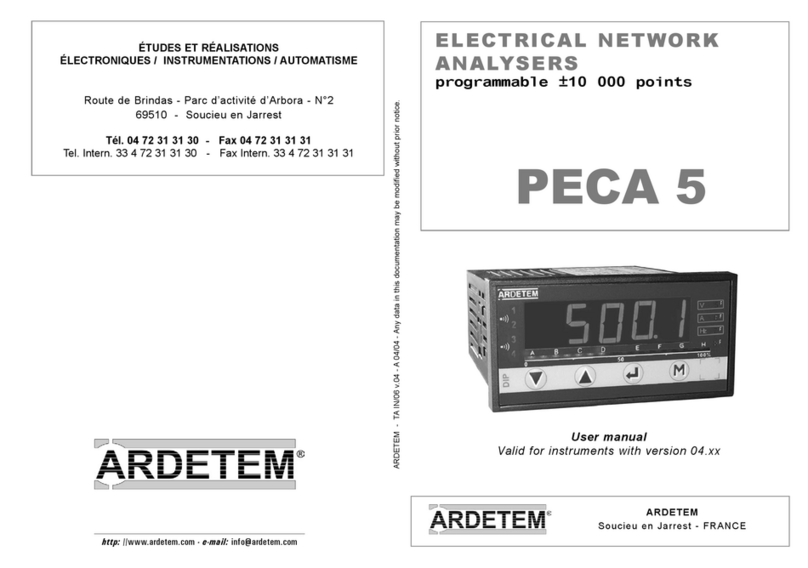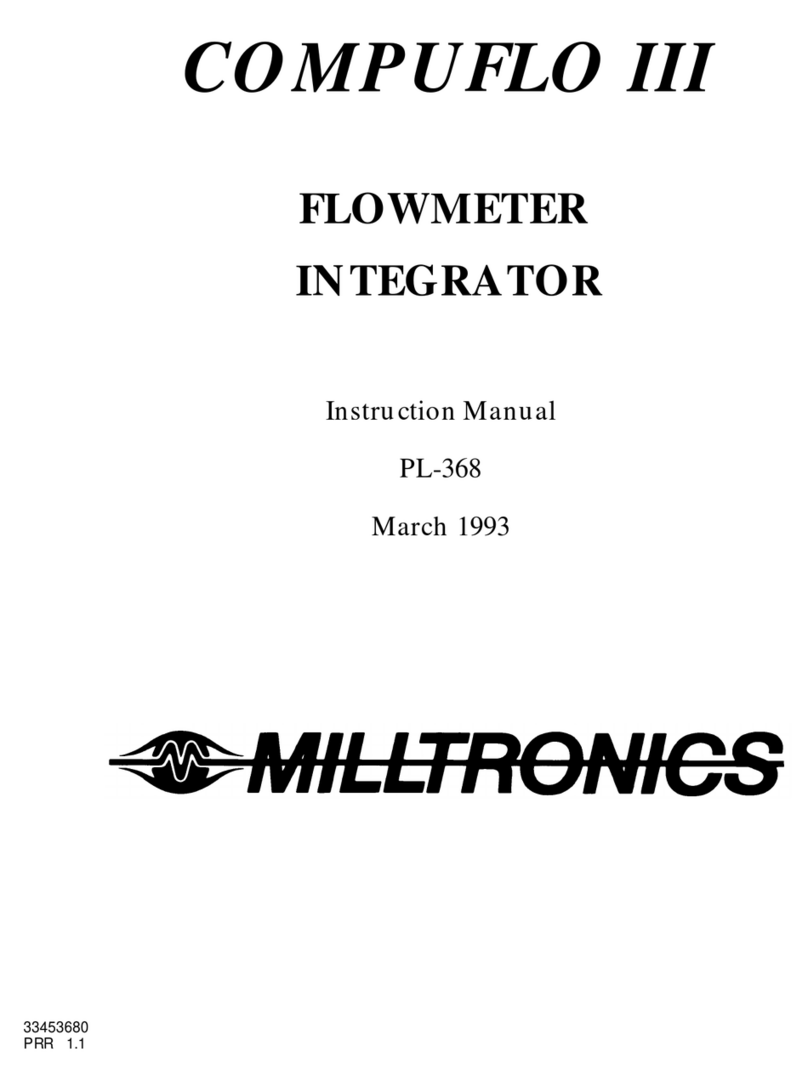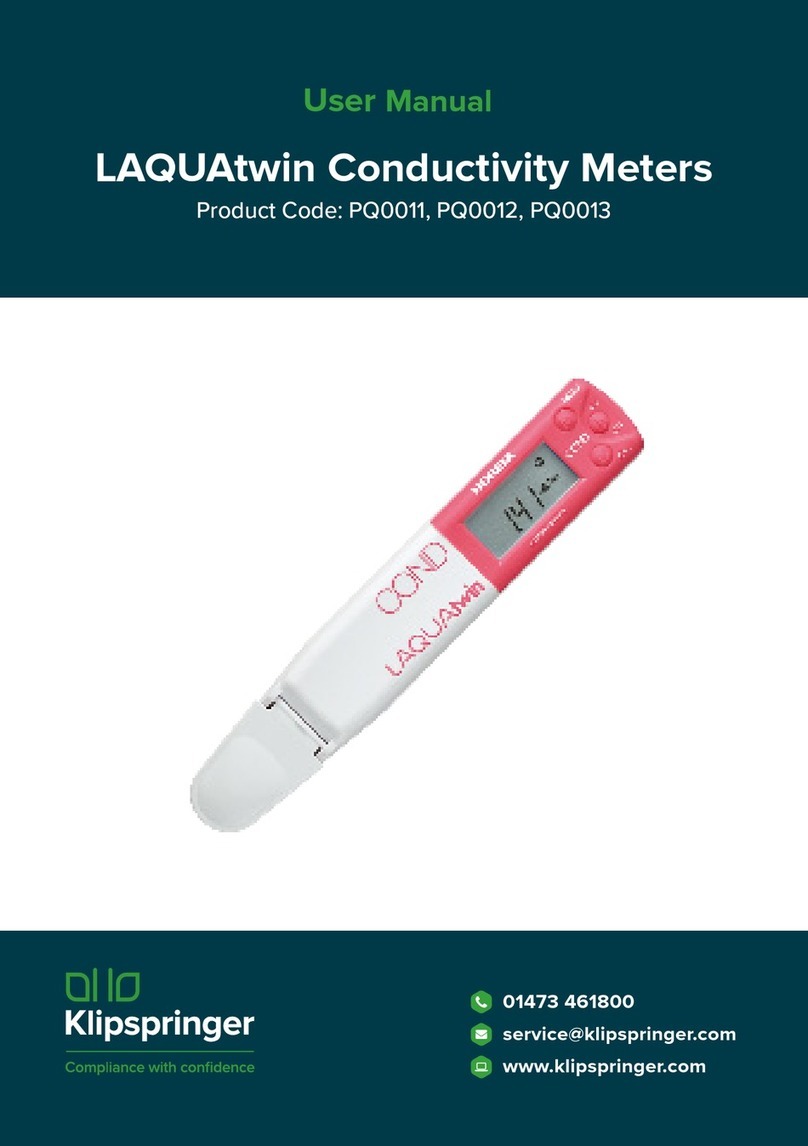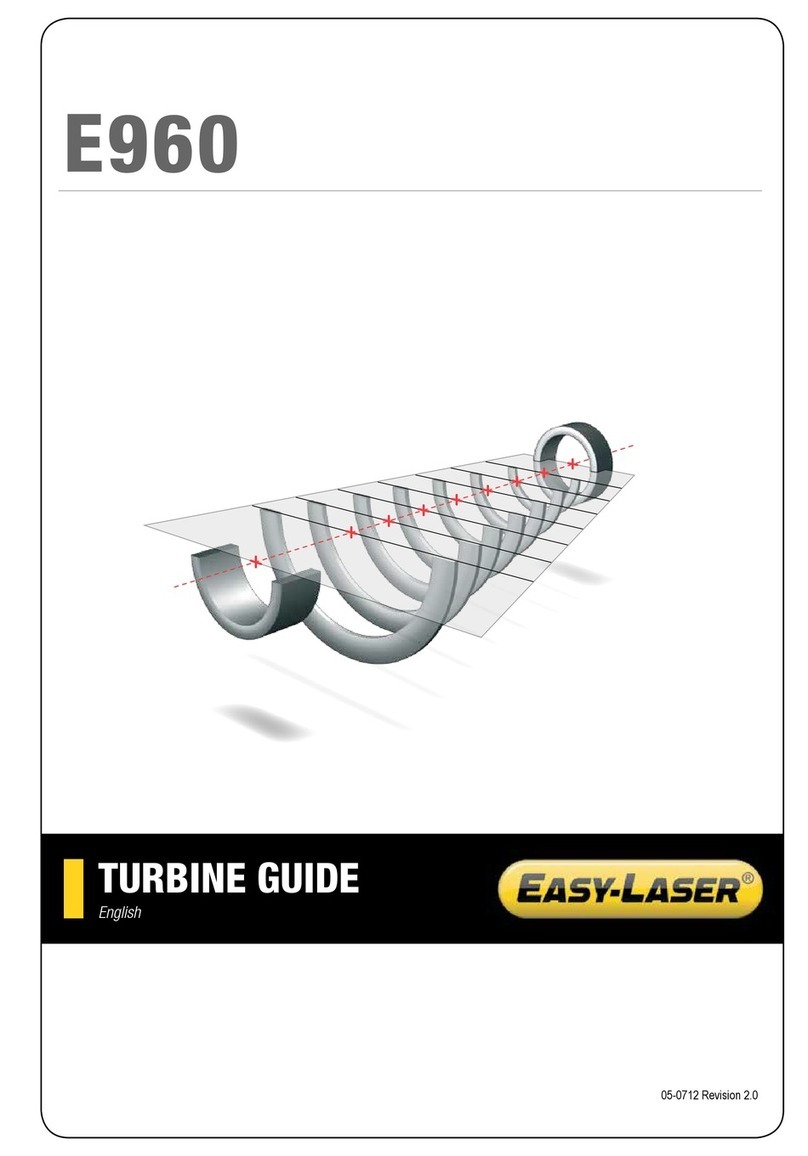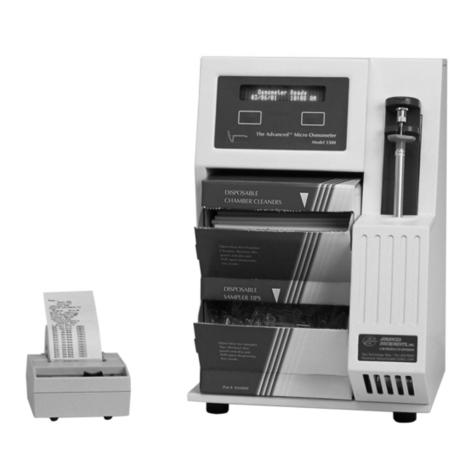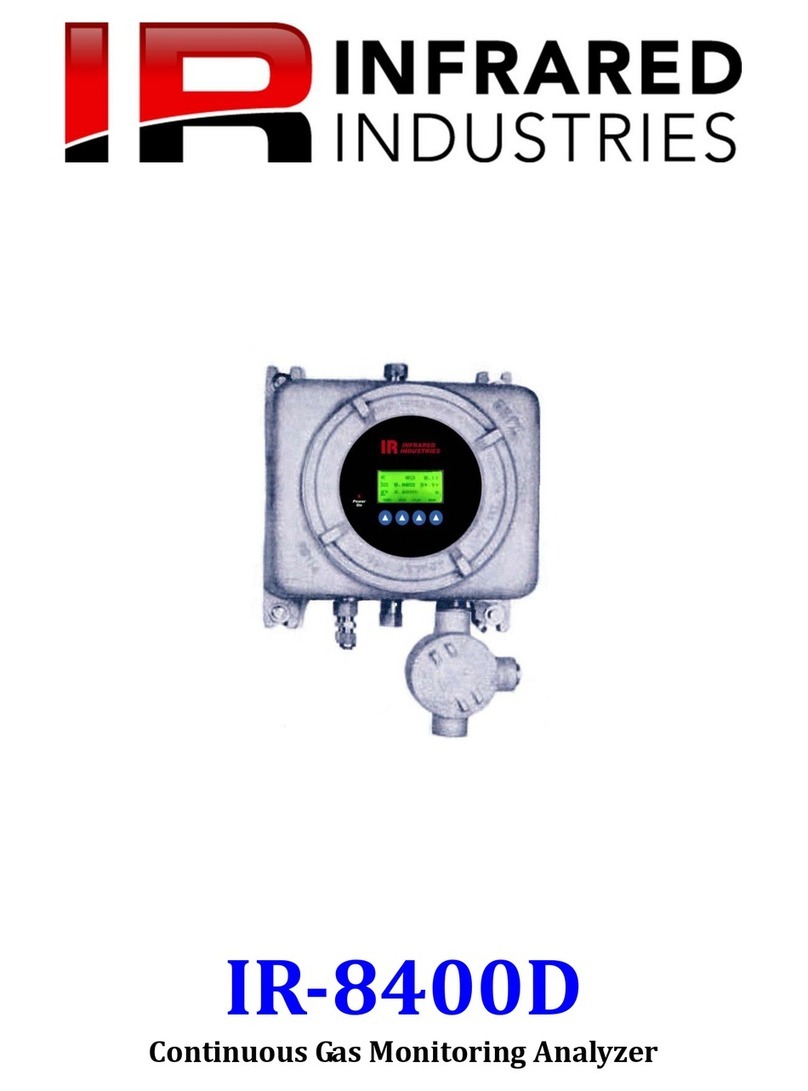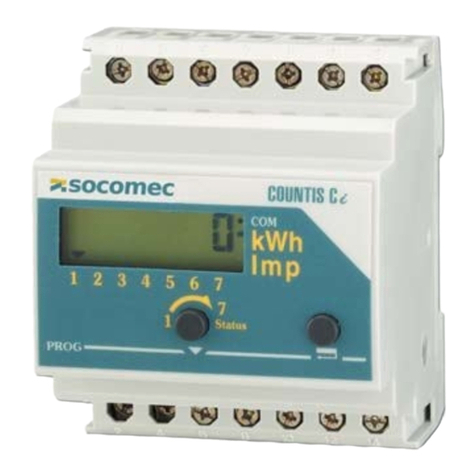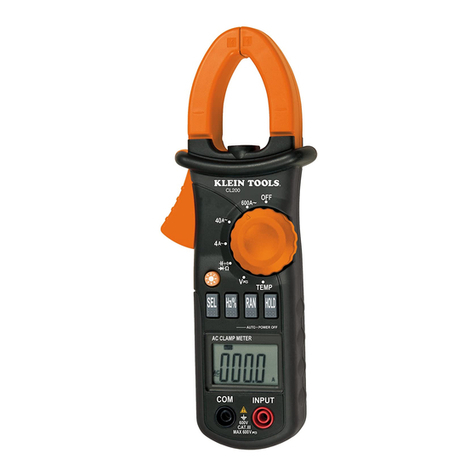TTI PSA2701T User manual

THURLBY THANDAR INSTRUMENTS
INSTRUCTION MANUAL
PSA-T SeriesPSA1301T & PSA2701T
1.3GHz & 2.7GHz RF Spectrum Analyzers

1
Table of Contents
1.Supplied Items 4
2.Using This Manual & Meaning of Terms 4
3.Initial Operations 4
3.1. Charging the Batteries 4
3.2. Initialising the Palm T|X 4
3.3. Software provided by Palm on CD 5
3.4. Linking to a Personal Computer 5
4.First Use of the Spectrum Analyzer 5
4.1. Quick Start Guide 5
4.2. Detailed Operating Guide 6
5.Product Description and Capabilities 6
6.Specification 8
6.1. Frequency Measurement 8
6.2. Amplitude Measurement 8
6.3. Sweep 9
6.4. Signal Input 10
6.5. Demodulation (Zero Span mode) 10
6.6. Display 10
6.7. Memory Storage 10
6.8. Connectors 11
6.9. Power Sources 11
6.10. Mechanical 12
6.11. Environmental and Safety 12
7.Declaration of Conformity 13
8.EMC 14
9.Safety 15
10.Connections 16
10.1. RF Signal Input 16
10.2. DC Power Input 16
10.3. Demodulated Audio Output 16
10.4. USB ‘through’ Connector 16
11.Stylus 17
12.Memory Card 17
12.1. Removing and Inserting the Card 17
12.2. Using an Alternative Card 17
12.3. Card Storage Capacity 18
13.Removing and Re-fitting the Palm T|X 18

2
14.Re-initialising the Palm T|X 19
14.1. Procedure for Re-Initialising 19
14.2. Technical Note about the OFF state 19
15.Language Choice for the Palm T|X 19
16.Turning On and Turning Off 20
16.1. Palm T|X On/Off 20
16.2. PSA1301/2701 On/Off Control 20
16.3. Operation Delay after Turning On 20
17.Battery and AC Power 21
17.1. Battery Operation 21
17.2. AC Power Operation 21
17.3. Extended Periods Without Use 22
18.Using the PSAnalyzer Application 22
18.1. Initial Conditions 22
18.2. Selecting and Leaving the Application 22
18.3. Touch Screen or Hard Key operation 22
18.4. The PSAnalyzer Screen 23
18.5. Operation and Navigation 23
18.6. Turning Off / Power Saving 24
19.The PSAnalyzer Menu System 24
19.1. Home Menu 24
19.2. Menus Summary 24
19.3. Mode Menu 25
19.4. Centre Menu 25
19.5. Step Value Sub Menu 26
19.6. Span Menu 26
19.7. Start Frequency Menu 27
19.8. Stop Frequency Menu 27
19.9. AM/FM Menu 28
19.10. Level Menu 28
19.11. Markers Menu 28
19.12. Sweep Menu 29
19.13. Traces Menu 30
19.14. Stores Menu 30
19.15. System Menu 31
19.16. Exit Menu 32
19.17. Quick Menu 32
20.PSAnalyzer Operating Techniques 33
20.1. Menu Navigation 33
20.2. Frequency Setting 33

3
20.3. Performing Sweeps 35
20.4. Level Measurements 35
20.5. The PRESET Key 36
20.6. Using Markers 36
20.7. Reference Trace 37
20.8. Store, Recall and Copy 37
20.9. Creating and Displaying Limit Lines 38
20.10. Screen Resolution and Trace Thickness 39
20.11. Changing the Palm Input Area type 39
20.12. Adjusting the Display Brightness 39
21.Help Screens 39
22.Functions outside of PSAnalyzer 40
22.1. Viewing a Stored Screen Image 40
22.2. Printing a Stored Screen Image (using a printer connected to a PC) 40
22.3. Transferring PSAnalyzer Files to a Personal Computer 40
23.PSAnalyzer Files and Defaults 41
23.1. Factory Default Settings for PSAnalyzer 41
23.2. File Locations for PSAnalyzer data files 42
23.3. File Structures for PSAnalyzer data files 42
24.Maintenance, Calibration and Repair 42
24.1. Screen Protection 42
24.2. Cleaning 43
24.3. Maintaining Battery Condition 43
24.4. Calibration 43
25.Trouble Shooting 43
25.1. Correcting Unexpected Conditions in PSAnalyzer 43
25.2. Resetting the Palm T|X 44
25.3. Reinstalling or Updating the PSAnalyzer application 44
25.4. Optional Accessories 45
25.5. Creating a Shortcut to PSAnalyzer 45

4
1. Supplied Items
The PSA1301T or PSA2701T portable spectrum analyzer is made up of three main items:
The PSA1301/PSA2701 spectrum analyzer unit manufactured by TTi and incorporating a Palm T|X
handheld computer.
The PSAnalyzer software application created by TTi to run on the Palm T|X.
An SD (or MMC) Memory Card for storing and transferring data
The following support items are also provided by TTi:
“Read This First” leaflet.
Universal mains adaptor/charger.
USB lead (mini B plug to standard Aplug).
SD/MMC USB Card Reader Printed instruction manual (English only).
Support CD containing multi-language manual and backup software.
M2.5 security screws to prevent easy removal of the Palm T|X (if required).
Transparent storage case for memory card.
The spectrum analyzer is supplied with the Palm T|X mounted into it, and the PSAnalyzer software
application pre-installed. The memory card is fitted into the Palm T|X.
Note: The SD/MMC USB Card Reader and other small items may be packed inside the shipping box.
2. Using This Manual & Meaning of Terms
Cross References within this Manual
This manual is also provided as multi-language PDF files. The manual includes many cross references
which are shown as follows - see section X.X.
Within a PDF file, the boxed number is a hyperlink to that section number, thus enabling the user to
jump rapidly the section referred to and then jump back to continue reading the text.
TTi
TTi is used throughout this manual as the abbreviation for Thurlby Thandar Instruments Ltd.
Handheld Computer and PDA
Devices such as the Palm T|X are commonly described as handheld computers, palmtop computers or
PDAs (personal digital assistants). The term ‘handheld computer’ is used throughout this manual.
PSA1301/2701
This is used to describe the spectrum analyzer unit excluding the Palm T|X handheld computer.
PSA1301/2701T
This is used to describe the complete spectrum analyzer unit including the Palm T|X handheld computer.
3. Initial Operations
3.1. Charging the Batteries
It is probable that the batteries will be discharged when the product is received. Consequently the first
action should be to charge the unit using the supplied mains adaptor. To fully charge the batteries it
should be left charging for 4 hours.
3.2. Initialising the Palm T|X
If the battery has been fully discharged, the Palm T|X handheld computer will have to be re-initialised
before the spectrum analyzer can be used. Details of how to re-initialise it are given in section 14.
Note: The PSA1301/2701 spectrum analyzer adaptor does not require any manual initialisation.

5
3.3. Software provided by Palm on CD
The software and support information provided by Palm assumes that you will want to link your Palm T|X
to a personal computer on a regular basis. The Palm “Read this First” manual instructs you to load the
CD software immediately as part of the initial set up.
Users of the PSA1301/2701T do not need to do this unless they choose to. TTi recommends that users
read the relevant sections of the Palm documentation and consider their own use of the product before
deciding whether to install to Palm software.
Note: Do NOT make a USB connection between the PSA1301/2701T (or the Palm T|X) and a PC
unless the Palm software has already been installed.
3.4. Linking to a Personal Computer
The following applies to both the PSA-T and the Palm T|X by itself. (The mini USB connection on the
side of the spectrum analyzer is a direct through connection to the USB port of the Palm T|X).
Although the Palm T|X was designed to be USB connected to a PC using Palm Desktop software, this
software is now obsolete and will not work with 64-bit operating systems.
It is NOT necessary ever to link the PSA1301/2701T to a personal computer. It is a self contained
instrument which can perform its primary function of RF spectrum analysis without linkage to other
devices. TTi provides a USB linked memory card reader in order that PSAnalyzer files can be
transferred to a PC where this is required.
4. First Use of the Spectrum Analyzer
After charging the battery and initialising the Palm T|X, it will then be possible to use the Spectrum
Analyzer by launching the PSAnalyzer application.
TTi recommends that you should read this manual in full before using the PSA1301/2701T.
However, if immediate use of the spectrum analyzer is required, the following procedure can be
used to start making measurements quickly.
4.1. Quick Start Guide
Before commencing - the batteries must have been charged and the Palm T|X initialised as
described in sections 3.1 and 14 respectively.
1. Connect the signal to be measured - connect signal to the SMA connector at the top of the
spectrum analyzer. The maximum allowable signal without damage is +20dBm (+127dBuV or
2.2 V rms). The maximum measurable signal is 0dBm (+ 107dBuV or 223 mV rms). If there is a
possibility of the signal exceeding these levels, add suitable in-line attenuation.
2. Launch the PSAnalyzer application - enter the Applications screen (by pressing the Home key
once or twice). Press the PSAnalyzer icon on the touch screen of the Palm T|X,
(the touch screen can be operated with a fingertip or the stylus of the Palm T|X).
3. Select the Mode Menu - press the on-screen Mode key.

6
4. Select Preset – press the Preset key.
This sets Quick Menu mode, Span maximum, Attenuation on, Highest RBW, Sweep mode
normal, Marker M1 on at the centre of the sweep.
5. Observe the Sweep - the sweep time will be slow because of the wide span.
6. Adjust the Attenuator – If the peak signal is below the –20dBm graticule line, press the Attenuator
On/Off key to toggle the attenuator to Off thus increasing the sensitivity.
7. Move the Marker – use the 5-way navigator to move the marker to the area of interest and position it
at the centre of the signals to be observed.
8. Centre the Sweep -.press the Set C=M1 key to re-centre the sweep around the new marker position
(Note: the span will be reduced to the maximum that can be achieved with the new centre
frequency)
9. Zoom the Span – Press the Zoom-In key successively to create a narrower span that shows more
detail of the signals of interest.
The above procedure should be sufficient to get started. Thereafter adjustments can be made to sweep
parameters, attenuator, resolution bandwidth, etc. as may be appropriate to the signals being observed.
Basic on-screen help information for every menu is available by pressing the Help hard key. Some
general information regarding the capabilities of the unit is available from the Info key on the Exit menu.
4.2. Detailed Operating Guide
To fully understand the operation of the PSA1301/2701T and PSAnalyzer, it is necessary to read this
manual.
From an operating point of view, the key sections are “Using the PSAnalyzer Application” section18,
“The PSAnalyzer Menu System” section 19, and “PSAnalyzer Operating Techniques” section 20.
5. Product Description and Capabilities
Brief Summary
The PSA-T series (PSA1301T and PSA2701T) are fully portable spectrum analyzers incorporating a
handheld computer (a Palm T|X). They are sufficiently small and lightweight to be operated as a
handheld instrument and has a typical battery life of four hours from each charge. Alternatively they can
be used as bench instruments using the supplied mains adaptor/charger. They can be set horizontally or
vertically, or at an angle of about 25 degrees using the built-in tilt stand.
The spectrum analyzer has a frequency range of 0.15 MHz to 1300 MHz (PSA1301T) or 1MHz to
2700MHz (PSA2701T). The span can be set anywhere between 0.320 MHz and 1299.850 MHz
(PSA1301T) or 2699.000 MHz (PSA2701T) with a resolution of 1kHz. Start, stop or centre frequencies
can be set to the same resolution. The resolution bandwidth is selectable as 280 kHz or 15 kHz
(PSA1301T) or 1 MHz, 280 kHz or 15 kHz (PSA2701T).

7
The on-screen amplitude range is 80 dB with a reference level of -20dBm or 0dBm. Amplitudes can
alternatively be displayed in dBµV. Vertical magnification to 5dB/div can be selected. Average noise
floor is better than -90dBm at -20dBm reference level and 15 kHz RBW.
Sweeps can be continuous, single shot, peak hold or average (2 to 256 sweeps). Sweep time is defined
by the span and resolution bandwidth, and varies between 0.1 sec and 30 sec. A zero span mode is
available with AM or FM audio demodulation.
Twin vertical marker lines are available giving a readout of frequency and amplitude to a resolution of 0.1
kHz and 0.1 dB. Markers can be manually positioned or automatically peak finding and tracking.
A reference trace can be displayed in addition to the live trace. Limit lines can also be created and
displayed.
The graticule is fully controllable. Any number of traces can be stored to permanent memory for recall to
the screen or for data export. Limit lines, instrument set-ups and complete screen bitmaps can also be
stored.
Battery life depends upon screen brightness, but is around four hours of continuous operation from a
charge. To conserve the battery, auto-sleep mode can be selected whereby the unit turns off
automatically after a defined period from the last key press. All data is retained when off.
Pressing the Help hard key brings up a help screen relevant to the current menu position.
Full details of the product capabilities are given with the Specification section 6and Using the
PSAnalyzer Application section 18 onwards.

8
6. Specification
6.1. Frequency Measurement
Frequency Span
Frequency Range: 150 kHz to 1300 MHz in one range (PSA1301)
1 MHz to 2700 MHz in one range (PSA2701)
Setting Modes: Centre frequency plus Span, or Start frequency plus Stop frequency
Maximum Span: 1299.85 MHz [150 kHz to 1300 MHz] (PSA1301)
2699 MHz [1 MHz to 2700 MHz] (PSA2701)
Minimum Span: 320 kHz, or Zero Span with demodulation
Setting Resolution: 1 kHz at any frequency
Setting Accuracy: Reference Frequency Accuracy for Start, Stop & Centre (Zero-Span) frequencies
Reference Frequency Accuracy
Initial Accuracy: Better than ± 10 ppm at 20oC
Stability: Better than ± 10 ppm over 10oC to 30oC
Ageing: Better than ± 3 ppm per year
Phase Noise
Phase Noise: Typically -100dBc/Hz at 100kHz offset at 500MHz (PSA1301)
Typically -90dBc/Hz at 100kHz offset at 500MHz (PSA2701)
Resolution Bandwidth
RBW: Selectable as 280 kHz or 15 kHz (PSA1301)
Selectable as 1 MHz, 280 kHz or 15 kHz (PSA2701)
Video Filtering: Selectable independently of RBW setting
Frequency Markers
Number of Markers: One, Two, or None
Marker Resolution: 0.1 kHz at all frequencies
Marker Accuracy: 1/320th of Frequency Span ± 0.1kHz + Reference Frequency Accuracy
Frequency Readout: Display of absolute and difference frequencies for both markers
6.2. Amplitude Measurement
Amplitude Range
Display Range: 80 dB
Measurement Units: dBm or dBµV (dB milliwatts or dB micro volts)
Reference Level: Selectable as -20 dBm or 0dBm (87 dBµV or 107 dBµV)

9
Amplitude Accuracy
Ref. Level Accuracy: Better than ± 1 dB at 50MHz at 10dB below reference level (20oC ± 5oC)
Level Flatness: Better than ± 1.5 dB relative to 50MHz over 500kHz to 1300MHz (PSA1301)
Better than ± 1.5 dB relative to 50MHz over 1MHz to 2700MHz (PSA2701)
Amplitude Linearity: Better than ± 1 dB over 50dB range down from reference level
Noise Floor
Noise Floor: Better than -93 dBm average displayed noise floor (PSA1301)
(reference level = –20 dBm, RBW = 15 kHz)
Better than -93 dBm average displayed noise floor for F > 3MHz (PSA2701)
(reference level = –20 dBm, RBW = 15 kHz)
Distortion and Spurii
3rd Order Intermod.: < –60dBc for two signals (500MHz and 501MHz) at 10dB below reference level
(PSA1301)
< –60dBc for two signals (500MHz and 502MHz) at 10dB below reference level
(PSA2701)
Harmonic: < –60dBc at 10dB below reference level (100MHz)
1st & 2nd Image: <– 55dBc, typically <– 60dBc
Residual Spurii: Below noise floor (PSA1301)
<3dB above noise floor (PSA2701)
Amplitude Markers
Number of Markers: One, Two, or None
Marker Resolution: 0.1 dB
Amplitude Readout: Display of absolute and difference amplitudes for both markers
Limit Lines
Limit lines are created from lists of amplitude & frequency points. Straight lines
are drawn between these points.
Displayed Lines: One, two (or none) differentiated by colour.
Line Storage Any number of limit lines can be stored.
6.3. Sweep
Sweep Method: Peak detection for 320 points per sweep. The amplitude of the peak level found
within each sub-span is stored (sub-span = span/320).
Sweep Time: Set automatically by Span and RBW.
Typically 200ms + 2ms/MHz of span for RBW = 1MHz (PSA2701 only)
Typically 200ms + 7ms/MHz of span for RBW = 280kHz
Typically 200ms + 75ms/MHz of span for RBW = 15kHz
Sweep Modes: Normal (continuous), Single, Peak Hold, or Average (2 to 256 sweeps)
Sweep Control: Separate buttons for Run and Stop. Peak Hold and Average are reset whenever
Run is pressed.

10
6.4. Signal Input
Input Connector: SMA connector, 50 Ohms
VSWR: 1.5:1 typical
Absolute
Maximum
Input Level:
+ 20 dBm or +127 dBµV (2.2V rms) or 15V dc
6.5. Demodulation (Zero Span mode)
Demod. Modes: AM or FM
Display: Carrier amplitude only (horizontal line).
Audio Out: 30 mW into 32 Ohms mono or stereo headphones, adjustable volume, 3.5mm
jack socket ( marked ) adjacent to the Signal Input.
Audio Filter Selectable low-pass filter to attenuate high frequency interference.
2 pole filter with turnover point at approximately 3 kHz.
6.6. Display
Display Type: 3.7 inch (9.4 cm) transflective backlit TFT LCD, 480 x 320 pixels total, 16 bit
colour, touch screen.
Trace Area: 300 x 320 pixels (high resolution mode).
Graticule: 8 x 10 divisions light grey graticule. Selectable as fully on, horizontal lines
only, or off).
Displayed Points: 320 points per sweep (peak detected).
Live Trace: Dot-joined trace from current or held sweep. Selectable on or off.
Reference Trace: Stored trace either recalled from memory or copied directly from live trace.
Selectable on or off.
Resolution Modes: Selectable as High Resolution or Low Resolution *
∗
In low resolution mode the trace area becomes 150 x 160 points where each point is a block of 4
pixels. Only 160 sweep points are displayed. This mode is useful in situations where the display could
otherwise be difficult to see - e.g. when the instrument cannot be viewed at an optimum distance.
6.7. Memory Storage
Memory Type: Non volatile Flash memory using removable SD or MMC memory cards.
Store Trace: Any number of traces can be stored under either default file names or user
entered file names. Traces are stored as tables of amplitude versus
frequency and can be imported into other programs, as well as being recalled
to the screen.
Recall Trace: Recalls any stored trace to the reference trace of the display.
Store Set-up: Any number of instrument set-ups can be stored under either default file
names or user entered file names. All settings of the instrument are saved.
Recall Set-up: Recalls any stored set-up, overwriting the existing settings of the instrument.

11
Store Screen: This function copies the whole screen area to memory as a bit-map. Any
number of screens can be stored under either default file names or user
entered file names. Screen bit-maps can be viewed using the “Media”
application of the Palm T|X, or transferred to a PC for printing.
Store/Recall Limit
Lines Any number of limit lines can be stored under either default file names or user
entered file names, and recalled as required.
6.8. Connectors
RF Input Connector: Standard SMA connector.
Power Connector: 1.3 mm dc power socket (centre positive) for 5.2V/1A external AC power
adaptor/charger as supplied by TTi.
USB Connector: Mini USB connector (5 pin mini B) which provides direct access to the USB port
of the Palm T|X.
Audio Connector: 3.5 mm jack socket for demodulated audio out (accepts mono or stereo plugs).
6.9. Power Sources
AC Line Operation/Charging
The PSA1301/2701T can be operated from mains power using the AC power adaptor provided by TTi.
This powers and recharges both the Spectrum Analyzer and the Palm T|X simultaneously.
AC Adaptor/Charger
Input Voltage Range: 100V to 240V nominal 50Hz/60Hz. Interchangeable plus for UK, Euro, USA
and Australia are supplied.
Battery Operation
The PSA1301/2701 and the Palm T|X contain their own internal rechargeable battery packs. The
PSA1301/2701 is turned off automatically whenever the PSAnalyzer program is exited, or when the
Palm T|X is turned off.
PSA1301/2701 Spectrum Analyzer
Battery Type: Ni-Mh 3.6V 700mA-hr (3 x AAA cell)
Battery Life: > 5 hours continuous operation (PSA1301)
> 4 hours continuous operation (PSA2701)
Recharge Time: < 3 hours from fully discharged
Palm T|X
Battery Type: Li-ion 3V 1050mA-hr
Battery Life: Typically 4 hours continuous operation (depending on backlight brightness)
Recharge Time: < 4 hours from fully discharged
Auto Sleep Mode
To conserve battery life, the system can be set to automatically switch into sleep mode after a defined
time from the last key press. This can be set between 5 mins and 60 mins (or never).

12
6.10. Mechanical
Size: 170mm high x 97mm wide x 47mm deep (including feet)
Weight: 495 grms total including Palm T|X.
Tilt Stand: Built-in tilt stand for bench use which angles the unit at approximately 25
degrees to the horizontal and can alternatively be used as a hook mount.
6.11. Environmental and Safety
Operating Range: +5oC to + 40oC, 20% to 80% RH.
Storage Range: -10oC to +50oC
Environmental: Indoor use at altitudes to 2000m, Pollution Degree 2.
Electrical Safety: Complies with EN61010-1.
EMC: Complies with EN61326.

13
7. Declaration of Conformity
EC Declaration of Conformity
We Thurlby Thandar Instruments Ltd
Glebe Road
Huntingdon
Cambridgeshire PE29 7DR
England
declare that the
PSA1301T and PSA2701T Portable RF Spectrum Analyzers
meet the intent of the EMC Directive 2004/108/EC and the Low Voltage Directive 2006/95/EC.
Compliance was demonstrated by conformance to the following specifications which have been
listed in the Official Journal of the European Communities.
EMC
Emissions: a) EN61326 (2006) Radiated, Class B
Immunity: EN61326 (2006) Immunity Table 1, referring to:
a) EN61000-4-2 (1995) Electrostatic Discharge
b) EN61000-4-3 (2006) Electromagnetic Field
c) EN61000-4-4 (2004) Fast Transient
Performance levels achieved are detailed in the user manual.
Safety
EN61010-1 Pollution Degree 2.
CHRIS WILDING
TECHNICAL DIRECTOR
1 May 2009

14
8. EMC
Spectrum Analyzer
This instrument has been designed to meet the requirements of the EMC Directive 2004/108/EC.
Compliance was demonstrated by meeting the test limits of the following standards:
Emissions
EN61326 (2006) EMC product standard for Electrical Equipment for Measurement, Control and
Laboratory Use. Test limits used were:
a) Radiated: Class B
Immunity
EN61326 (2006) EMC product standard for Electrical Equipment for Measurement, Control and
Laboratory Use.
Test methods, limits and performance achieved are shown below (requirement shown in
brackets):
a) EN61000-4-2 (1995) Electrostatic Discharge : 4kV air, 4kV contact, Performance A (B).
b) EN61000-4-3 (2006) Electromagnetic Field:
3V/m, 80% AM at 1kHz, 80MHz – 1GHz: Performance B (A) and 1.4GHz to 2GHz:
Performance B (A); 1V/m, 2.0GHz to 2.7GHz: Performance B (A).
Note: The PSA-T Series spectrum analyzers are extremely sensitive instruments and, as
a result, show some susceptibility to high electromagnetic fields throughout their
measurement range. In general, the instrument will operate correctly but may show the
interfering frequencies on the measurement trace if the levels are very high.
c) EN61000-4-4 (2004) Fast Transient, 0.5kV peak (signal input), Performance B (B).
Performance Definitions
The definitions of performance criteria are:
Performance criterion A: ‘During test normal performance within the specification limits.’
Performance criterion B: ‘During test, temporary degradation, or loss of function or
performance which is self-recovering’.
Adaptor/Charger
This AC adaptor/charger has been designed to meet the requirements of the EMC Directive
2004/108/EC.
Compliance was demonstrated by meeting the test limits of the following standards:
Emissions
EN55022, radiated and conducted Class B.
Immunity
EN55024:1998/A1:2001/A2:2003, referring to:
a) IEC 61000-4-2 (2001) Electrostatic Discharge.
b) IEC 61000-4-3 (2002) Electromagnetic Field.
c) IEC 61000-4-11 (2004) Voltage Interrupt.
d) IEC 61000-4-4 (2004) Fast Transient.
e) IEC 61000-4-5 (2001) Surge.
f) IEC 61000-4-6 (2003) Conducted RF.

15
9. Safety
Spectrum Analyzer
This instrument is Safety Class III according to IEC classification and has been designed to meet the
requirements of EN61010-1 (Safety Requirements for Electrical Equipment for Measurement, Control
and Laboratory Use).
This instrument has been tested in accordance with EN61010-1 and has been supplied in a safe
condition. This instruction manual contains some information and warnings which have to be followed by
the user to ensure safe operation and to retain the instrument in a safe condition.
This instrument has been designed for indoor use in a Pollution Degree 2 environment in the
temperature range 5°C to 40°C, 20% - 80% RH (non-condensing). It may occasionally be subjected to
temperatures between +5° and -10°C without degradation of its safety. Do not operate while
condensation is present.
Use of this instrument in a manner not specified by these instructions may impair the safety protection
provided.
WARNING!
All accessible parts will be at the same voltage as the outer body of the SMAinput socket. In particular,
note that the shell of the mini-USB connector is galvanically connected to the body of the SMA input
which will therefore be at earth ground potential when the USB port is connected to a desktop PC. To
maintain user safety under all other circumstances it is essential that the input is not connected to a
voltage above 30Vdc or 30Vrms with respect to earth ground which is the limit of Safe Extra Low Voltage
(SELV) by IEC definition.
The instrument shall be disconnected from all voltage sources before it is opened for any adjustment,
replacement, maintenance or repair.
Any adjustment, maintenance and repair of the opened instrument under voltage shall be avoided as far
as possible and, if inevitable, shall be carried out only by a skilled person who is aware of the hazard
involved.
Do not wet the instrument when cleaning it.
The following symbols are used on the instrument and in this manual.
Direct Current
CAUTION – refer to accompanying documentation.
Damage to the instrument may occur if these precautions are ignored.
Adaptor/Charger
The adaptor/charger supplied has a universal input voltage rating of 100-240VAC, 50/60Hz. It is a
Class II (double insulated) device, fully approved to EN 60950-1 (2001), UL 60950 (UL listing E138754)
and AS/NZS CISPR:2002 (C-Tick).

16
10. Connections
10.1. RF Signal Input
The signal to be measured is connected via a standard (non reverse) SMAconnector mounted at the top
of the instrument. The input impedance is 50 Ohms. The maximum allowable input is +20dBm or
+127dBuV of RF power (approximately 2.2 volts RMS), or 15V DC.
Applying a signal above these levels could damage the unit and such damage would not
be covered by the product warranty.
It should be noted that SMA connectors have a limited mechanical life and that, where frequent
connection and disconnection is expected, a sacrificial intermediate connector should be used.
10.2. DC Power Input
DC power to operate and/or recharge the instrument is connected via a 1.3mm power socket mounted
on the side of the instrument.
Use ONLY the mains adaptor provided by TTi with the unit. Use of any other power source will
void the warranty.
The batteries of the spectrum analyzer unit and of the Palm T|X are automatically charged whenever dc
power is connected.
An LED adjacent to the socket shows that the batteries of the PSA1301/2701 are recharging. When
they are fully charged this LED will go off. The charging state and charge level of the Palm T|X batteries
is shown on the display of the T|X, see section 17.1
10.3. Demodulated Audio Output
Demodulated audio (when in Zero Span Mode) is provided via a 3.5mm stereo jack socket ( marked )
mounted at the top of the instrument adjacent to the RF Signal Input. Maximum power output is
32 milliwatts into 32 Ohms with the volume level adjustable from within the application.
The signal is mono but connection can be made using either a mono or stereo plug. In the latter case
the signal will be present on both channels.
10.4. USB ‘through’ Connector
The USB port of the Palm T|X can be accessed via a mini USB connector (mini type B) mounted on the
side of the instrument. A cable is provided to connect this to a standard computer USB port.
Note that the USB interface has no function within the PSAnalyzer application, the cable is supplied in
order that Palm Desktop software can be used with the Palm T|X in situ within the PSA1301/2701T.
Note: The USB cable should be disconnected at the PSA1301/2701T end when using the PSAnalyzer
application.
Important - Do NOT try to make a USB connection to a PC which has not had the appropriate
software loaded onto it.

17
11. Stylus
Handheld computers such as the Palm T|X are normally operated using the supplied stylus. The
PSAnalyzer application has been written so that use of a stylus is not a requirement, see section 18.2 .
Nevertheless some users may prefer to operate it using a stylus.
The stylus provided with the Palm T|X clips into a slot on its right hand edge. When the T|X is fitted into
the PSA1301/2701, the stylus fits into the same slot but is prevented from sliding as far down as normal
by a stop incorporated within the top cover. This ensures that the stylus remains easily accessible.
Note: If access to the stylus is not required, it can be pushed past the stop. If this is done, however, it
will not be possible to access it without removing the Palm T|X from the PSA1301/2701T.
12. Memory Card
The PSA1301/2701T is supplied complete with a Flash memory card (type SD or MMC). This card is
necessary for storing and recalling traces, screens and set-ups in PSAnalyzer. A backup of the original
PSAnalyzer program is also stored on the card.
The memory card can be used in many other Palm applications, both as additional memory and as a
convenient way of sharing data with other devices. Note: Palm documentation refers to a memory card
as an expansion card.
PSAnalyzer can be used without any card in place, but storing or recall of traces, screens or set-ups will
not be available.
The memory card can be used as a means of transferring data to and from a PC using the USB card
reader supplied.See section 22.3 for details.
12.1. Removing and Inserting the Card
The card fits into a slot on the top left hand edge of the Palm T|X and is slightly recessed relative to the
top edge of the PSA1301/2701.
To remove the card, press it down and then release it (a confirmation tone may be heard). The card
becomes free and can be slid out. To insert the card, slide it into the slot and press it down firmly until a
click is felt and the confirmation tone is heard.
Note: When a card is inserted, the Applications screen is automatically switched to show the
applications which are on the card. In the case of the card supplied with the PSA1301/2701T this will be
the utility PSAInstaller. To return to the normal Applications screen, select the drop down menu at the
top right and select “All” in place of “Card”.
12.2. Using an Alternative Card
Any SD (secure digital) or MMC (multi media) card that is compatible with the Palm T|X can be used in
place of the one supplied. When PSAnalyzer stores a file it automatically creates the required folder
structure. Multiple cards could be used increase total capacity or to separate files related to different
projects. Note that the maximum card size useable with the Palm T|X is 2GB.
Note: The original card should be retained as it contains an important utility and a backup of the
PSAnalyzer application. This card is labelled with the TTi logo and with the version number of the
supplied PSAnalyzer software.

18
12.3. Card Storage Capacity
The size of the memory card supplied by TTi may vary from time to time, but will be in the range 512MB
to 2GB.
The size if the files stored by PSAnalyzer are very small in comparison. Set-up files are a few hundred
bytes each, trace files are around six kilobytes each, and screen bitmap files are 120 kilobytes each.
Note, however, that the FAT16 format of the card creates a minimum file allocation size of 16 kilobytes
(or possibly greater) for any file stored.
13. Removing and Re-fitting the Palm T|X
All of the functionality of the Palm T|X is available when it is mounted within the PSA1301/2701 spectrum
analyzer. However, users may wish to remove it in order to carry it in their pocket as a personal
organiser or to use for other purposes. Removing and re-fitting is quick and simple.
Removing
Re-fitting
Remove the Stylus from the Palm T|X. Push the Palm T|X onto the connector by pushing it firmly in the
line of the instrument.
Ensure that the two fixing latches are open. Locate the top cover onto the rear of the instrument and
lower it down, then operate the two fixing latches to secure it. Refit the Stylus.
Preventing Unauthorised Removal
In circumstances where removal of the Palm T|X is regarded as undesirable, the top cover can be
secured using screws which fit underneath the two latches. TTi provides Torx head screws for this
purpose (M2.5 size) although they are not fitted.
Lift the two latches close to the top
of the unit and remove the silver
top cover (see drawing). Remove
the Palm T|X by gripping its sides
and pulling it towards the top edge
of the spectrum analyzer. (Note
that the connector is a tight fit and
that a hard pull may be needed).
Note: the top cover could be
secured by screws under the
latches which must be removed
first (see section Preventing
Unauthorised Removal below).

19
14. Re-initialising the Palm T|X
Whenever the battery of the Palm T|X has been allowed to completely discharge (as is normally the
case when it is first received) it will be necessary to re-initialise it.
14.1. Procedure for Re-Initialising
Charge the Palm T|X in the normal way. After a short period (normally less then 10 minutes) the battery
voltage will recover to a point where normal operation is possible. The T|X may then switch itself on
automatically, or it may be necessary to turn it on manually (using the green button on the top edge).
At this point a Palm logo will appear on the screen and the unit will reboot (i.e. the operating system will
reload) as indicated by moving black bars on the screen. When this is complete the user will be
prompted to confirm or re-enter the real-time clock information (date, time, location) and confirm user
preferences.
When this has been completed the Palm T|X is ready for use, however it should be left charging for
several more hours before disconnecting it from the ac power adaptor/charger.
In exceptional circumstances, the Palm T|X may fail to re-initialise after being re-charged. Should this
happen it will be necessary to operate the “Reset” button on the back of the T|X. To do this, remove the
T|X from the PSA1301/2701 (see “Removing and Re-fitting the Palm T|X” above), and use the Palm
stylus to press the reset button, see section 25.2. It should then re-initialise.
14.2. Technical Note about the OFF state
Handheld computers operate on the principle of being ‘always on’. When they are turned ‘off’, they
merely go into a low power consumption mode with the display and other functions disabled - this is
often referred to as Sleep mode. When turned back on, they restart instantly without the delay that would
be caused if the operating system had to be reloaded.
Consequently when ‘off’, a small amount of power is still being taken from the battery. It is assumed that
the user will keep the unit charged and never let the battery fully discharge.
In most handheld computers, allowing the battery to fully discharge would cause all of the user’s data to
be lost. However, the Palm T|X uses permanent Flash memory which prevents user data from being lost
if the battery is fully discharged. The real-time clock, however, cannot continue to run with a fully
discharged battery.
If the unit is left unused and unconnected to its charger for an extended period (typically several weeks)
the battery will discharge to a point where re-initialisation is needed.
The batteries of the PSA1301/2701 will also discharge over an extended period of time, but no re-
initialisation should be required.
15. Language Choice for the Palm T|X
As supplied with the PSA1301/2701T, the operating language of the Palm T|X has been set to English.
It is possible to change this to French, German or Spanish, but the change should be made before the
product is first used. Note that the Spectrum Analyzer software remains in English.
See the Read This First leaflet for instruction on changing the language.
This manual suits for next models
1
Table of contents
Other TTI Measuring Instrument manuals
